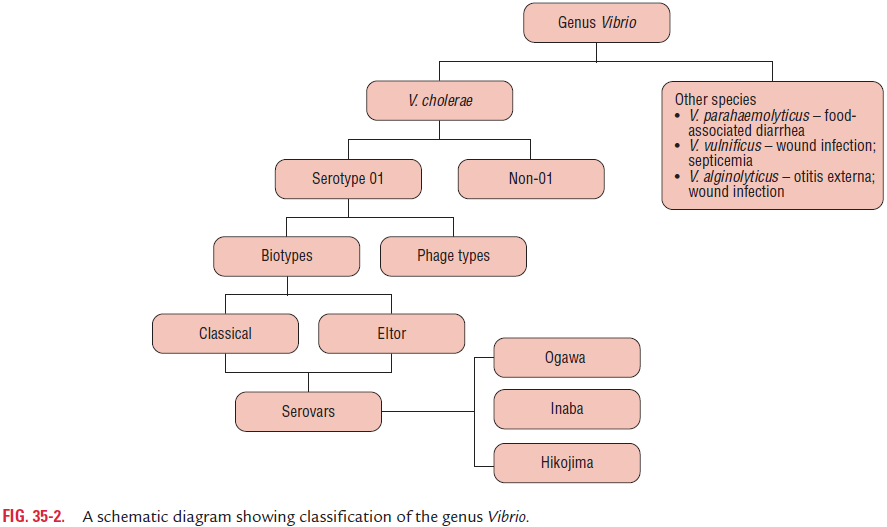Chapter: Microbiology and Immunology: Bacteriology: Vibrio,Aeromonas,and Plesiomonas
Cell Wall Components and Antigenic Structure - Vibrio cholerae
Cell Wall Components and Antigenic Structure
V. cholerae like that of Gram-negative bacilli also possesses thelipopolysaccharide (LPS). The LPS has no role in the pathogen-esis of cholera but is responsible for the immunity produced by killed V. cholerae vaccine. V. cholerae possesses two antigens:
· Somatic O antigen is present in the cell wall of the bacteria. It is a group-specific antigen
· Flagellar H antigen is a heat-labile antigen present in the flagella and is shared by all strains of V. cholerae.
◗ Serological classification
V. cholerae has been classified according to somatic carbohy-drate O antigen into many serotypes. This serological classi-fication was suggested by Gardner and Venkatraman (1935). More than 200 serotypes have been described, which have been classified broadly into two groups—V. cholerae O1 and non-O1 cholerae:

· cholerae O1 agglutinate with antisera to the O1 group andare called cholera vibrios or agglutinable vibrios. V. cholerae O1 is subdivided into two biotypes—Eltor and Classical, on the basis of their biochemical parameters. Each biotype has been divided further into three subtypes—Ogawa, Inaba, and Hikojima (Table 35-3). This classification is based on the differences in minor O antigens, such as A, B, C. Serotype Ogawa contains A and B antigens, Inaba contains A and C antigens, and Hikojima contains all three antigens A, B, and C. Hence, Hikojima strains are agglutinated by both Ogawa and Inaba antisera, whereas Ogawa and Inaba strains are agglutinated by their own specific antisera only.
· Non-O1 V. cholerae, which do not agglutinate with O1 group antisera, are designated as noncholera vibrios or nonagglu-tinating vibrios (Fig. 35-2). Noncholera vibrios are classified into 138 serotypes designated from O2 to O139. Of these serotypes, only V. cholerae O139 causes cholera in humans.

Rest of the serotypes (O2–O138) do not cause any disease in humans.
◗ Phage typing
V. cholerae O1 biotype Classical has been divided into five typeson the basis of four phages (I, II, III, and IV). All these phages lyse biotype Classical but not Eltor strains. On the basis of these four phages and an additional fifth phage, V. cholerae bio-type Eltor can also be divided into six types.
◗ Biotyping
On the basis of fermentation of mannose, sucrose, and arabi-nose, Vibrios have been classified by Heiberg (1934) into six groups (I, II, III, IV, V, and VI); subsequently, two more groups have been added. V. cholerae belongs to group I.
Related Topics